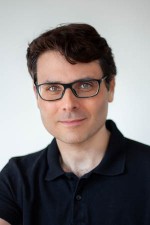- >Discover our teams
- >MitoLab
- >Medical Data & Technologies
Medical Data & Technologies
Marc Ferre, Lecturer
Keywords : Bioinformatics, Molecular biology, Mitochondria, Databases, direct DNA sequencing
State of the art and objectives
Marc Ferré graduated in 2002 from a French Grande Ecole of Engineering (ESEO, https://eseo.fr) and got his PhD in Bioinformatics in December 2009. Until August 2014, he was employed by the University Hospital of Angers (France) as bioinformatician through the formation of a national network coordinated by the French Department of Health (genetic study of neuromuscular and sensory pathologies, and mental retardation). He is currently Associate Professor in Molecular Biology and Bioinformatics at the Angers Medical School.
Main results from the last 5 years
- He began his career by studying in silico the human mitochondrial proteome and developing a bioinformatics research strategy to identify new mitochondrial proteins on the basis of their prokaryotic origin. In parallel to this overall strategy of screening, he focused on the study of the OPA1 protein, one of the proteins associated with dominant optic atrophy, which is involved in mitochondrial fusion. He developed an international database listing the variations of OPA1 and its mutational spectrum. This tool was used as a complement to a multicentric clinical molecular diagnosis service involving thousands of patients with optic neuropathy. His work has led to the development of novel bioinformatic tools that contribute to a better understanding of mitochondrial pathophysiology.
- He is currently focused on three axes: (1) designing and curating clinico-biological databases of genes involved in neuro-ophthalmological diseases (ACO2, DNM1L, MFN2, OPA1, RTN4IP1, SPG7), as a member of the Human Variome Project since 2012; (2) exceeding the current reading limits of the human mitochondrial genome sequence, via an innovative technique in which the complete double-stranded mitochondrial DNA is read directly without DNA amplification or incorporation of nucleotides; (3) analyzing the big data generated by the two previous axes, by , bioinformatics and biostatistical methods, and artificial intelligence.
- h-index : 21 (or Hirsch index; i.e., 21 articles are cited more than 21 times; calculated using Web of Science Core Collection citation data).
- 42 scientific articles in international peer-reviewed journals since 2004, including 40 original and 2 review articles, 5 first (2005–2015) and 4 last author (2011–2021).
- Cited 1,319 times (1,247 without self-citations), an average of 33.79 citations per article (calculated using Web of Science Core Collection citation data).
- IF: impact factor of the scientific journal indexed in the Clarivate Journal Citation Reports for the year the article was published (if available).
People involved
- Angélique Caignard, MD (axis 1)
- Bastien Le Roux, MD (axis 1)
- Delphine Prunier-Mirebeau, MD, PhD (axes 1, 2, 3)
- Floris Chabrun, MD (axes 1, 3)
- Juan Manuel Chao de la Barca, MD, PhD (axes 1, 3)
- Julien Cassereau, MD, PhD (axis 1)
- Khadidja Boutellis, MD student (axis 1)
- Pascal Reynier, MD, PhD (axes 1, 2, 3)
- Patrizia Amati-Bonneau, MD (axis 1)
- Thomas Foulonneau, MD student (axis 1)
- Valérie Desquiret-Dumas, PhD (axis 2, equal contribution)
- Xavier Dieu, MD (axes 1, 3)
Main publications and patents from the last 5 years
- NR2F1 database: 111 variants and 83 patients support refining the clinical synopsis of Bosch-Boonstra-Schaaf optic atrophy syndrome. B. Billiet, P. Amati-Bonneau, V. Desquiret-Dumas, K. Guehlouz, D. Milea, P. Gohier, G. Lenaers, D. Mirebeau-Prunier, J. Den Dunnen, P. Reynier, M. Ferré. Authorea, 2021. Soumis à Human Mutation, en cours de révision. (IF 2020 : 4,9)
- Dominant Optic Atrophy: How to Determine the Pathogenicity of Novel Variants? A. Z. J, S. Raviskanthan, P. W. Mortensen, M. Ferre, P. Reynier, D. Milea and A. G. Lee. J Neuroophthalmol, 2021. (IF 2020 : 3,0)
- Achieving Expert-Level Interpretation of Serum Protein Electrophoresis through Deep Learning Driven by Human Reasoning. F. Chabrun, X. Dieu, M. Ferre, O. Gaillard, A. Mery, J. M. Chao de la Barca, A. Taisne, G. Urbanski, P. Reynier and D. Mirebeau-Prunier. Clin Chem, 2021. (IF 2020 : 8,3)
- ACO2 clinicobiological dataset with extensive phenotype ontology annotation. K. Guehlouz, T. Foulonneau, P. Amati-Bonneau, M. Charif, E. Colin, C. Bris, V. Desquiret-Dumas, D. Milea, P. Gohier, V. Procaccio, D. Bonneau, J. T. den Dunnen, G. Lenaers, P. Reynier and M. Ferré. Scientific Data, 2021. (IF 2020 : 6,4)
- OPA1: 516 unique variants and 831 patients registered in an updated centralized Variome database. B. Le Roux, G. Lenaers, X. Zanlonghi, P. Amati-Bonneau, F. Chabrun, T. Foulonneau, A. Caignard, S. Leruez, P. Gohier, V. Procaccio, D. Milea, J. T. den Dunnen, P. Reynier and M. Ferre. Orphanet J Rare Dis, 2019. (IF : 3,5)
- Multiethnic involvement in autosomal dominant optic atrophy in Singapore. L. Loo Jing, S. Singhal, A.V. Rukmini, S. Tow, P. Amati-Bonneau, V. Procaccio, D. Bonneau, J. Gooley, P. Reynier, M. Ferré, D. Milea. Eye, 2016. (IF : 2,2)
Collaborations
- Dan Milea (Singapore Eye Research Institute, Duke-NUS, Singapore; https://www.snec.com.sg/patient-care/find-a-doctor/Ophthalmology/dan-milea).
- Johan T. den Dunnen (Human & Clinical Genetics, Leiden University Medical Center, Leiden; https://www.universiteitleiden.nl/en/staffmembers/johan-den-dunnen).
- The Human Variome Project (international non-governmental organisation; http://www.humanvariomeproject.org).
Acknowledgements for the financial supports
- Kjer France
- Ouvrir les Yeux
- Retina France
- Union nationale des Aveugles et Déficients visuels
- Association contre les Maladies mitochondriales



